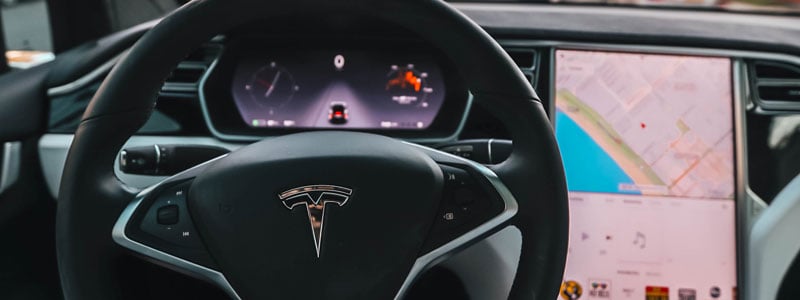All modern vehicles are equipped with certain mandatory safety features. Some cars have advanced systems that are designed to help you avoid accidents while others are designed to minimize injury if an accident does occur. The safety features in your car may reduce the risk of a serious crash by 49% and lower injury risk by 53%. They can also impact your insurance rates and affect your eligibility for car sharing.
This guide explains the purpose of car safety features and describes how some of the most common safety features work to protect you and your passengers. It’s a great reference to have on hand when shopping for a new car.
What Are Car Safety Features?
Safety features in cars are the parts that are built-in or added to your vehicle to improve safety and car security. They minimize the chances of getting in an accident or reduce the effects of a collision. When multiple safety measures work together, accidents and injuries are minimized significantly. Safety features can be passive (like seat belts and airbags) or active (like stability control and automatic emergency braking). Many vehicle safety features are federally mandated, but some aren’t.
Car Safety Features
Car companies often advertise safety features to entice consumers to invest in new cars. However, long lists of auto jargon can be challenging to understand (especially during the excitement of purchasing a new vehicle). This list includes the most common car safety features and elaborates on their purpose and effectiveness. By learning more about safety features, you can have a better idea of what to look for in your next vehicle.
Airbags
Airbags inflate during a crash to prevent drivers and passengers from coming into contact with the car’s hard surfaces (like the steering wheel). An airbag system uses sensors to determine the force of a crash and immediately creates a chemical reaction to forcefully inflate an airbag in less than half a second. Some systems have the technology to measure the weight and position of occupants and reduce the force of curtain airbag deployment to minimize injury.
Front seat airbags have been mandatory since 1999. However, many newer cars and SUVs offer at least six (in a combination of front and side airbags), and the Toyota Camry provides 10. While some individuals are concerned about airbags and car safety due to the force of airbag deployment, they are essential in reducing death rates in frontal collisions.
Safety Belts
All drivers today are familiar with safety belts (seat belts). They are frequently referred to as the most important car safety feature. These vital safety features strap drivers and passengers comfortably in place and lock when sudden movements occur. They cinch tight in the event of an accident, to keep individuals from colliding with hard interior car parts or being thrown from the vehicle in the event of an accident.
Mandatory since 1968, the seatbelt is essential for all cars to minimize injury and prevent death for vehicle occupants during an accident.

Antilock Brakes
Your car’s antilock brake system is made up of sensors on each wheel that connect to the car’s computer and brake devices on each wheel. They report performance factors like speed and grip to the car’s computer and react with brake assist to help the driver maintain steering control during emergency braking.
Mandatory since 2000, these systems are essential for improving driver control.
Traction Control
Particularly useful in wet or icy driving conditions, a vehicle’s traction control system uses the antilock brake system to momentarily brake a spinning wheel. The action sends power to the opposite wheel to improve control of the vehicle.
Mandatory since 2012, traction control provides essential driver assistance during dangerous driving conditions.
Backup Camera
This rear-pointing camera, also known as a rearview camera, is located within a vehicle’s rear lower trim pieces and automatically activates when you shift into reverse. It’s designed to improve visibility behind your car beyond the capability of your rearview mirror and is invaluable for spotting pedestrians while backing up.
Mandatory since 2018, this is an essential feature, especially in crowded city streets, parking lots, etc.
Electronic Stability Control
Designed to keep the vehicle traveling in the direction you’re steering, electronic stability control (ESC) uses ABS and traction control sensors along with other sensors to measure sideways motion and steering angle. When the vehicle isn’t headed in the direction the front wheels are pointed (skidding) the stability control uses tactics like applying brakes to specific wheels and reducing engine speed to get things back on track.
Mandatory since 2012, this safety technology is vital to avoid accidents.
LATCH (Lower Anchors and Tethers for Children)
This system keeps child safety seats in place with an anchor in an automobile’s bottom seat cushion provides to connect clips on the bottom of child safety seats. Tethers located at the top of safety seats then clip onto tether anchors built into the seat’s back.
Mandatory since 2002 for all passenger cars, LATCH systems are essential for vehicles transporting children in any type of safety seat.
Tire Pressure Monitoring System
This system uses a sensor inside each tire to monitor air pressure. Some systems constantly display the current pressure in each tire while others send a warning when tire pressure is low. Since tire pressure changes due to weather and other factors, drivers are often unaware when pressure is low. Optimal tire pressure improves vehicle performance under all road conditions.
Mandatory since 2007 and essential to avoid tire blowouts at high speed and improve driver control of the vehicle.
Blind-Spot Monitoring (BSM)
While automakers work to improve driver visibility with mirrors and windows, all cars have blind spots that can make actions like lane changes dangerous. A vehicle’s blind spot monitoring system uses sensors on both sides and the rear of the car to alert drivers to vehicles entering your blind spots. Blind spot warnings typically take the form of warning lights or a head-up display.
BSM systems aren’t mandatory, but they are essential to avoid collisions with cars, pedestrians, or other objects you can’t see from the driver’s seat.
Forward Collision Warning
A forward collision warning system is composed of cameras, radar, lasers, or a combination of the three. It detects cars or other objects in front of your vehicle and issues a warning. Depending on your system’s sophistication level, the warning may be visual, audible, or tactile (uses sensors to slow, steer, or stop the vehicle).
While this feature isn’t currently mandatory, it’s a crucial system for pedestrian detection and avoiding collisions with other vehicles.
Intersection Turn Assistance (ITA)
This system is designed to examine intersections for potential collisions with the use of cameras and sensors. It alerts you to vehicles, pedestrians, or cyclists crossing your path and provides warnings and automatic braking if you don’t react.
The feature isn’t currently mandatory on vehicles, but it is essential for highly trafficked areas.
Lane-Centering Assist (LCA)
A function that engages when adaptive cruise control is in use, LCA takes an active role in keeping your vehicle centered in its lane. The system uses forward-pointed cameras to monitor lane boundaries and steering assist to navigate curves.
Lane-keeping assist systems aren’t mandatory. However, it’s an indispensable safety feature for drivers who use cruise control.

Lane Departure Warning (LDW)
A vehicle’s LDW system uses a front-mounted camera to monitor your vehicle’s proximity to lane markings. When it sees the car is veering close to markers on either side, it issues a warning to prompt the driver to steer back on track. Some systems include steering assist to subtly nudge you back into your lane. The system will also engage if you don’t use your turn signal when it’s time to change lanes.
Although it’s not mandatory, this system is crucial for preventing accidents with other vehicles or rollover accidents due to veering off the road.
Automatic Windshield Wipers
Weather is unpredictable and it’s easy to wait until it’s too late to turn on or speed up your vehicle’s windshield wipers. Rain-sensing wipers engage when the system senses moisture on the windshield. The system automatically adjusts wiper speed as rain volume changes.
Automatic windshield wipers aren’t currently mandatory and may be described as a nice feature to have. However, the system does perform the essential service of reducing driver distractions and improving safety during dangerous driving conditions.
Automatic High Beams
Sometimes called high-beam assist or adaptive headlights, this system relies on a forward-pointing camera or sensor to identify the headlights of approaching vehicles or taillights as you near a vehicle in front of you. The system must be manually turned on for use, at which time it engages the high beams until headlights or taillights are detected. Since the system operates automatically, it represents one less activity for drivers to complete manually.
Automatic high beams aren’t currently mandatory. However, they’re essential to provide a safe driving environment for all drivers on the road.
Automatic Emergency Braking
A vehicle’s automatic emergency braking (AEB) system relies on cameras, radar, sensors, or a combination of these tools to identify objects in a vehicle’s path. The system sends messages to the vehicle’s computer to determine the potential for a collision. The system will then respond by slowing or stopping the car completely to avoid a collision.
This system isn’t currently mandatory. However, it may be in the future as it’s essential for avoiding collisions in many unexpected situations.
Driver Attention Monitor
This system is composed of advanced safety features that use a sensor-equipped camera with LED detectors. It monitors a driver’s alertness through eye movements, head position, eyelid activity, etc. Some systems can track steering behavior and other performance factors as well.
While this system isn’t currently mandatory in vehicles, it might be in the future. Driving forces an individual to stay still in an enclosed space for long periods of time and can lull drivers to sleep. A driver attention monitor sees the signs of waning alertness and issues visual or audio warnings before an accident occurs.
Passive Disabling Device
If you’ve ever wondered what is a passive disabling device, you’re not alone. Passive disabling devices are security features that automatically engage based on a vehicle’s activity. They can include automated alarm systems, automatic door locks, and even sensors that can detect if the proper key is being used to start the car.
While these systems aren’t mandatory, they are essential for reducing theft and can lower your insurance rates.
Various safety features and systems are created by automakers to improve vehicle safety in a variety of ways. By learning more about these features, you can shop for vehicles with the most advanced features to keep you and your passengers safe while traveling the roadways.







